Original URL: https://www.theregister.com/2010/12/06/ordnance_survey_rehoused/
Inside the Ordnance Survey's new HQ for the digital era
Building designed with servers – and job losses – in mind
Posted in Legal, 6th December 2010 10:39 GMT
In the past year, the Ordnance Survey organisation has survived a huge government cull of quangos, the prospect of ugly public sector cutbacks and a big shake-up of its licensing model. But the UK mapping service now arguably faces its biggest challenge yet: A move to a new office that, for many of its workers, is already proving to be a major culture shock.
I visited the Ordnance Survey office last month to find out how it will shortly be shifting its staff, paperwork and computers away from the org’s fusty old 1960s hospital-like, asbestos-ridden grey building in Southampton to a shiny new headquarters 10 minutes up the road on the outskirts of the city.

What's most striking about the OS is that while its employee headcount has dramatically shrunk from close to 5,000 workers in the mid-'60s to a little over 1,000 people on its books today, the trading fund has clearly outgrown its current office.
Parts of the old building in Romsey Road, Southampton, are crumbling away, while elsewhere there are sad, abandoned rooms that once housed paper maps – which of course were the Ordnance Survey’s raison d'être before the advent of digital technology. Gone too is the obligatory tea lady and her trusty rusty trolley. I can report, however, that a government-sponsored Web2.0 robot pouring tea while providing Twitter updates has not replaced her – yet.
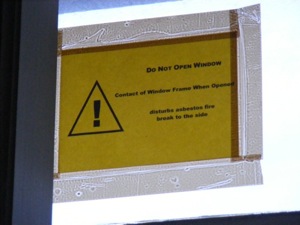
Asbestos warnings feature throughout the old OS building
Interestingly, the OS service plodded on at the old office bereft of a proper server room. Instead, as the computer revolution took off, the old building served as a kind of grand but eccentric old aunt to the demands of new technology that was foisted onto the mapping service.
This meant that there was no air-conditioning for the many servers dotted all over the building. I was assured during my visit that the OS suffered very little downtime due to the fact that it always had a backup system in place. But still, readers of The Register will surely now let rip a collective ‘WTF’ at such a fundamental neglect of server-humming harmony.
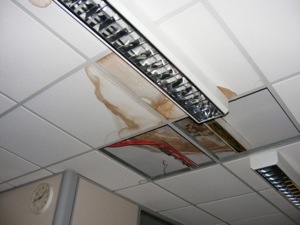
This leak was perilously close to a standalone server cabinet bereft of air-con
No surprise then that the new building simply throws the old one into sharp relief. The Ordnance Survey’s board of directors cobbled together £40m to bring it to life during a gestating project that took the best part of a decade to be realised. But the team behind the build got there – and on budget – just as the first government cutbacks from the ConDem Coalition started to fly.
Data-chugging office is go
In January 2011, OS staff will begin occupying the space at Adanac Park. Before that, its IT department has a huge job to do.
The agency’s head of IS delivery, Simon Williams, tells me that the Ordnance Survey’s tech team will be moving 500 servers to the new building over the course of the next 12 weeks.
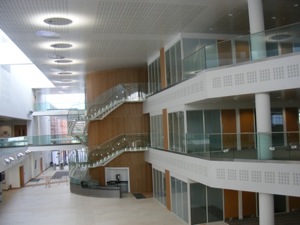
Dreadfully swish civil servant working quarters
“We’ve certainly taken the opportunity to do some modernisation, but it hasn’t been comprehensive because we wanted to keep the scope of the project relatively limited,” Williams says. “But we have implemented a brand new network and fitted out a brand new data centre.”
The organisation began leasing a shared Gloucester-based data centre from the Land Registry in October 2009. The hosting strategy for that end of the operation, undersigned by Computacenter and Cisco, has been secured for the next 10 years, Williams says.

Racking up
As part of the Ordnance Survey’s 750tbs data shift to its new home, the IT team has already moved 300 physical and virtual hosts to its West Country data centre in the past five months.
On the operating system side of the house, the OS has no immediate plans to upgrade its systems, Williams says.
“We have strong ties with Oracle, Linux Red Hat and Microsoft,” he explains. “Our VMs are mostly Microsoft. That’s predominantly because of the ties with the rest of our estate – we’re very much a Microsoft shop in terms of Active Directory, our operating systems and Office package.”
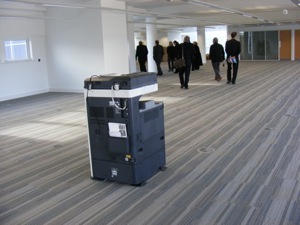
Are you lonesome tonight?
But given the unease among many pro open-source and open standards public sector workers and would-be partners right now, is the Ordnance Survey’s close relationship with Microsoft set to change in the near future?
“Not in the short-term, no,” says Williams. “There will be a strategic review of our client offering next year when we’ll look at the most appropriate solution for the business – and that may or may not change our relationship with Microsoft. But it’s currently too early to say.”
But how free is free?
In April this year, as the previous incumbent of Number 10 awaited defeat at the hands of the UK electorate, the Ordnance Survey began releasing to British citizens some of its mapping data for free re-use.
It’s now been six months since the ConDem Coalition was formed, so what does that mean for the OpenOS data project?

“It’s not in flux. The last government had a very clear strategy about making public sector information as freely used as possible,” says the agency’s biz sales and support head John Kimmance.
“[As a trading fund] We have a commercial contract with the government, which means we are paid to release and maintain data into the market and the current government is following the same trajectory as the previous one when it comes to freely used data."
The biz sales head adds: “By free, it depends on how much the cost of data will impact on the government to offer that. And that’s essentially what they [the Coalition] are looking at. So it may well be that more OS data will become free to use down the line, but that’s still to be looked at.”
Given the financial burden involved with essentially footing some of the bill for the Ordnance Survey, is it likely that the org will eventually be sold off as a private business?
“I’m not sure, but it doesn’t make a difference one way or the other. You’ve got an engine room creating a load of data with a whole bunch of surveyors capturing it. That’s delivering a service that the public sector, in particular, is benefiting from and we get commercial revenues from it, too. If the government gave it all away for free, you still need the infrastructure in place to pay for that,” explains Kimmance.
“It doesn’t change the operational side of things, but it might change the business.”
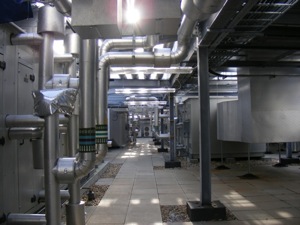
Dr Who-like ground source heat pump system heats, cools building
Meanwhile, the Ordnance Survey, which pulled in sales of £114.3m in 2009/10, is expecting to see revenue growth, despite freeing up some of its data and the fact that the current economic climate is frosty.
Concerns around the free-at-the-point-of-use data so far released have focused mainly on the contentious issue of derived data. However, in October this year, the Ordnance Survey debuted a new product-licensing model to help simplify the pricing of its digital wares.
But regardless of how much data the OS frees up, it is still shackled to agreements with organisations that refuse to apply the same ethos to its products.
The Royal Mail’s PAF database file is one such example, which Kimmance hesitantly comments on.
“As far as the public sector is concerned, it has been talking with the Royal Mail to come up with some sort of a deal, but I’m not sure where they’ve got to on that. Our addressing products use the Royal Mail’s PAF and therefore the Royal Mail has a set of terms and conditions that we are obliged as a licensee of the company to pass on,” he says.
“We try to make the use of our data as free as possible, for example within the public sector mapping agreement, but if the Royal Mail’s terms aren’t as free as that then we’re a bit stuck.”
In essence, the Ordnance Survey is a value-added reseller of PAF, so it has no say in how that data is divvied out.
So what about the big cash splurge on the Ordnance Survey’s building, and will the soon-to-be-laid-off civil servants affected by the government’s quango bonfire and public sector cutbacks think that the flash opening of Adanac Park is poorly timed?
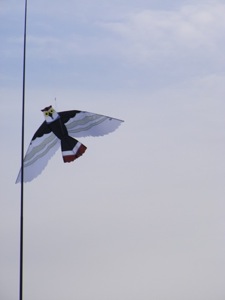
This fella can ward off pigeons, apparently
“Behind the snazzy building is the fact that we have also taken cuts in terms of headcount and the staff rehousing was planned eight years ago. In terms of efficiency, cost perspective – take aside the capital investment – it will be better to run,” says Kimmance.
Interestingly, the Ordnance Survey’s new home also hints at a future where space could be shared with other government agencies, such as, for example, with some Land Registry workers.
“If we decide to downsize, we can do that and the building has been designed so that different wings can be let out to other organisations if need be … We’re no different to the rest of the public sector in terms of cuts, we’re in the same bucket and are not immune to cuts,” says Kimmance.
“The building is designed so we can expand or shrink, and there won’t be a problem letting out a wing that can be self-contained.”
Culture shock - mapping out the future
Behind the glamour of the impressive new build are the Ordnance Survey employees, many of whom have worked at the old office since it was opened by the Queen in 1969. Some of them have remained at the same desk for years, building up stacks of paperwork, wearing out the same bit of carpet and generally treating the tired old place like a home from home.

This is where the magic will happen, it's believed
And unsurprisingly, those same workers don't like change and the prospect of moving to a swanky new building fills many of them with dread.
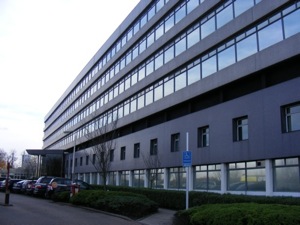
Grim old building awaits bulldozer
The cultural shift is enormous for an organisation still in the process of re-defining itself as an agency fit for the demands of a digital age. That said, the Ordnance Survey is still very much in the business of selling paper maps, with over three million sold in the past year alone.
But then the OS, unlike so many of its quango peers, has survived a massive government cull and in fact continues to reshape its business by increasingly, so far at least, improving its offering both to the public and private sectors.
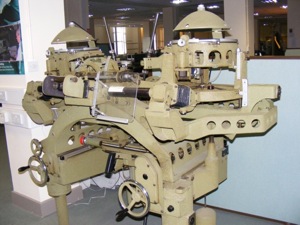
But will this old A8 stereo plotter get rehoused?
The outfit's HR boss Jan Hutchison says of the OS: “Today we are a 21st century digital business, and the changes in technology over the past 40 years mean we now employ far fewer people than we did in 1969. Our new building has been designed specifically to meet the needs of modern map-making and it’s very exciting to now be finally moving in.”
The open-plan office at Adanac Park will likely feel alien to OS staff when they unpack their possessions there in the New Year. But there is one small glimmer of hope. A public footpath has already been built that leads straight to the local pub. ®